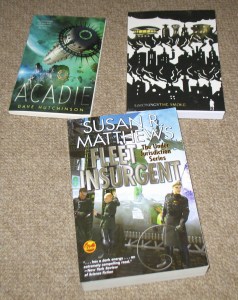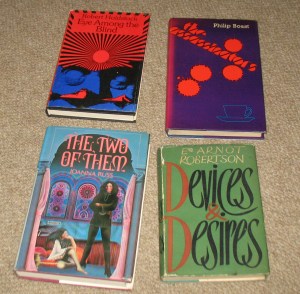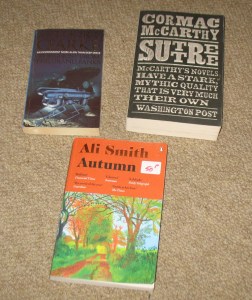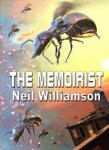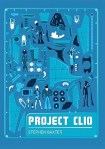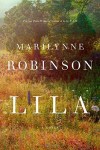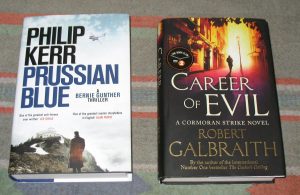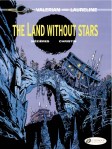This is the third in a series of posts about the “100 Books That Shaped My World”, as inspired by the list published by the BBC. Parts one and two are here and here.
And so we come to…
The 1990s
The major event in the 1990s which impacted by reading habits was moving to the United Arab Emirates. One of the first things I did on arriving in Abu Dhabi was join a subscription library – the Daly Community Library, run by Jocelyn Henderson – which was a real life-saver… but did not have much of a genre collection. So I was forced to read further afield. I had started reading literary fiction (not a term I like) a few years earlier during my last year in Coventry, but that was more in the nature of exploration. In Abu Dhabi, I had no choice: if I wanted to take out four books a fortnight, I could not do so if they were only genre, the library simply didn’t have enough of them.
 The Innocent, Ian McEwan (1990). I borrowed this book from Coventry Central Library, and it’s one of the first “literary fiction” novels I remember reading. I probably read others before The Innocent, and certainly there were books I studied at school that weren’t science fiction or fantasy, but I’m fairly sure this was the first novel I read I consciously identified as “literary fiction”. I continued reading McEwan for many years afterward, but eventually gave up on his books after reading Saturday and hating it.
The Innocent, Ian McEwan (1990). I borrowed this book from Coventry Central Library, and it’s one of the first “literary fiction” novels I remember reading. I probably read others before The Innocent, and certainly there were books I studied at school that weren’t science fiction or fantasy, but I’m fairly sure this was the first novel I read I consciously identified as “literary fiction”. I continued reading McEwan for many years afterward, but eventually gave up on his books after reading Saturday and hating it.
 Use of Weapons, Iain M Banks (1990). I first met Iain Banks at the second convention I attended, Prefab Trout in Glasgow in 1989, but at the 1990 Eastercon in Liverpool the editor of a magazine called Back Brain Recluse borrowed my hotel room for an interview with Banks. About a dozen of us sat in on it. As far as I know, the interview never saw print. Use of Weapons was also launched at the con, so I bought a copy and got it signed. I think I’d read a couple of Banks’s novels prior to that weekend, but after reading Use of Weapons I made sure to pick up each new book as it was published – both Iain M Banks and Iain Banks. In first edition.
Use of Weapons, Iain M Banks (1990). I first met Iain Banks at the second convention I attended, Prefab Trout in Glasgow in 1989, but at the 1990 Eastercon in Liverpool the editor of a magazine called Back Brain Recluse borrowed my hotel room for an interview with Banks. About a dozen of us sat in on it. As far as I know, the interview never saw print. Use of Weapons was also launched at the con, so I bought a copy and got it signed. I think I’d read a couple of Banks’s novels prior to that weekend, but after reading Use of Weapons I made sure to pick up each new book as it was published – both Iain M Banks and Iain Banks. In first edition.
 Take Back Plenty, Colin Greenland (1990). I remember the fuss when this was published. Greenland had previously published three literate fantasies, was also known as a critic (and a co-editor of Interzone), and was a well-respected name in British sf. Take Back Plenty, word had it, was something very different, a literate science fiction novel that made knowing use of pulp sf tropes. Word was correct. Take Back Plenty showed me that tropes were not only the building-blocks of science fiction but they could also be interrogated. And they could be deployed in a narrative that used literary tricks not commonly found in science fiction. (Many years later on this blog, I would take a second look at the deployment of tropes in science fiction, and the unacknowledged baggage those tropes carried.) Take Back Plenty remains an important novel in British science fiction; and in my own approach to the genre. It’s no longer as popular as it once was, and its importance seems to have been lost in the success of Banks’s space operas. Banks wrote superior space opera, true, but it was less consciously literary than Greenland’s sf; and, of course, Banks published considerably more books.
Take Back Plenty, Colin Greenland (1990). I remember the fuss when this was published. Greenland had previously published three literate fantasies, was also known as a critic (and a co-editor of Interzone), and was a well-respected name in British sf. Take Back Plenty, word had it, was something very different, a literate science fiction novel that made knowing use of pulp sf tropes. Word was correct. Take Back Plenty showed me that tropes were not only the building-blocks of science fiction but they could also be interrogated. And they could be deployed in a narrative that used literary tricks not commonly found in science fiction. (Many years later on this blog, I would take a second look at the deployment of tropes in science fiction, and the unacknowledged baggage those tropes carried.) Take Back Plenty remains an important novel in British science fiction; and in my own approach to the genre. It’s no longer as popular as it once was, and its importance seems to have been lost in the success of Banks’s space operas. Banks wrote superior space opera, true, but it was less consciously literary than Greenland’s sf; and, of course, Banks published considerably more books.
 Raft, Stephen Baxter (1991). I met Stephen Baxter at a convention in the late 1980s, and we would often hang out together. There was a group of us who hung out together at UK cons – some had been published, some hadn’t, but quite a few went on to have careers as science fiction writers and are still being published now. I’d read several of Baxter’s stories in British small press magazines – does anyone remember Dreams and New Moon Quarterly? At that time, a typical sf writer’s career progression went: publish short stories in small press magazines, publish short stories in Interzone, attract interest of genre imprint editor, submit novel or collection… I seem to remember Baxter’s debut was originally going to be a collection of Xeelee stories but his editor decided a novel was safer. Anyway, Baxter added me to a list at his publisher so I’d receive review copies (it wasn’t as easy for an individual to get review copies then as it is now). I was sent copies of his first four books as they were published, but then my parents sold their house and moved abroad. After that, I had to buy my own copies.
Raft, Stephen Baxter (1991). I met Stephen Baxter at a convention in the late 1980s, and we would often hang out together. There was a group of us who hung out together at UK cons – some had been published, some hadn’t, but quite a few went on to have careers as science fiction writers and are still being published now. I’d read several of Baxter’s stories in British small press magazines – does anyone remember Dreams and New Moon Quarterly? At that time, a typical sf writer’s career progression went: publish short stories in small press magazines, publish short stories in Interzone, attract interest of genre imprint editor, submit novel or collection… I seem to remember Baxter’s debut was originally going to be a collection of Xeelee stories but his editor decided a novel was safer. Anyway, Baxter added me to a list at his publisher so I’d receive review copies (it wasn’t as easy for an individual to get review copies then as it is now). I was sent copies of his first four books as they were published, but then my parents sold their house and moved abroad. After that, I had to buy my own copies.
 The Brains of Rats, Michael Blumlein (1989)
The Brains of Rats, Michael Blumlein (1989)
Semiotext(e) SF, Rudy Rucker, Peter Lamborn Wilson & Robert Anton Wilson, eds. (1989). I’d been hugely impressed by Blumlein’s story, ‘Tissue Ablation and Variant Regeneration: A Case Report’, when I first came across it in, I think, an Interzone anthology. It was shocking but I loved its – no pun intended – clinically sharp prose. Naturally, I bought his first collection when it was published (I upgraded my copy to a signed slipcased edition a few years ago). I was not the only fan of the story among the people I hung out with at conventions at that time (a slightly different group to the one mentioned above). We were all into a particular group of US sf writers who appeared, or were discussed, in the magazine SF Eye and, later, Journal Wired, particularly the more gonzo science fiction writers. And you couldn’t get more gonzo than Semiotext(e) SF. It further helped shape my understanding of science fiction, a demonstration the genre wasn’t limited to the sort of heartland sf found in those books I’d bought from WH Smith and the like in the 1970s and 1980s…
 Metrophage, Richard Kadrey (1988). Kadrey was one of the aforementioned SF Eye authors and Metrophage was his debut. I have long maintained its publication pretty much killed cyberpunk as a serious sf subgenre. The 1980s had seen me explore heartland sf widely, discovering new authors and notables works both old and new. During the 1990s, my definition of the genre expanded – well, perhaps not definition, more that my view of sf had been quite “trad” and I’d previously interpreted what I read in light of that view. I had, for example, read Tiptree in the very early 1980s (after she had been outed), but had not read her stories as feminist (feminism was not something I knew of as a thing at that time, although I agreed with its aims and had even internalised some of them). Metrophage was one of the first novels I read which gave me the beginnings of a critical framework for my appreciation of science fiction. I still think the novel is hugely under-rated.
Metrophage, Richard Kadrey (1988). Kadrey was one of the aforementioned SF Eye authors and Metrophage was his debut. I have long maintained its publication pretty much killed cyberpunk as a serious sf subgenre. The 1980s had seen me explore heartland sf widely, discovering new authors and notables works both old and new. During the 1990s, my definition of the genre expanded – well, perhaps not definition, more that my view of sf had been quite “trad” and I’d previously interpreted what I read in light of that view. I had, for example, read Tiptree in the very early 1980s (after she had been outed), but had not read her stories as feminist (feminism was not something I knew of as a thing at that time, although I agreed with its aims and had even internalised some of them). Metrophage was one of the first novels I read which gave me the beginnings of a critical framework for my appreciation of science fiction. I still think the novel is hugely under-rated.
Dreamside, Graham Joyce (1991). I met Graham Joyce at Mexicon 4 in Harrogate during a weekend in May 1991. He was there to help promote his first book, Dreamside. I offered to interview him for a magazine I co-edited, The Lyre, and pretty much read Dreamside in a single day as preparation. Unfortunately, the interview took place on the Sunday, after many of us had stayed up until about 4 am drinking the previous night, and neither Joyce nor myself were feeling particularly smart. Weeks later, I sent him a verbatim transcript, and he wrote back that he remembered the interview as “quite insightful… so who were those two fucking Martians on the tape?”. I lost touch with Joyce after I left the UK, and I was never much of a fan of the genre in which he wrote, although I did read several of his novels. When I first met him, I could not have predicted how important he would prove to British fantasy, but he was a force for good and is sorely missed.
 Iris, William Barton & Michael Capobianco (1990). Prior to my departure for the UAE in 1994, I was part of a group of young UK sf fans and writers who attended conventions, were members of the BSFA, read and were published in UK small press magazines, and possessed a mostly homogeneous taste in fiction – which in no way mapped onto the tastes of fans of the previous generation. I had perhaps read more of the older stuff than many of the group, but we were all keen (mostly) on the same US and UK genre writers. Except for William Barton and Michael Capobianco (and, later, William Barton alone). I was the only fan among us of the pair’s books. I’d regularly recommend their books, but either my friends didn’t read them or, if they did, they weren’t as impressed as I had been. And this despite the fact Iris was approvingly reviewed in SF Eye. I suspect Barton and Capobianco were too much hard sf rather than flavour of sf du jour (which was sort of post-cyberpunk), and I’ve always been more hard sf than my friends in fandom. My own writing is no doubt proof of this. But Barton and Capobianco, and later Barton solo, have been for me a mini-fandom of my own within my fandom cohort. (Coincidentally, Barton wrote about Traveller for RPG magazines early in his career.)
Iris, William Barton & Michael Capobianco (1990). Prior to my departure for the UAE in 1994, I was part of a group of young UK sf fans and writers who attended conventions, were members of the BSFA, read and were published in UK small press magazines, and possessed a mostly homogeneous taste in fiction – which in no way mapped onto the tastes of fans of the previous generation. I had perhaps read more of the older stuff than many of the group, but we were all keen (mostly) on the same US and UK genre writers. Except for William Barton and Michael Capobianco (and, later, William Barton alone). I was the only fan among us of the pair’s books. I’d regularly recommend their books, but either my friends didn’t read them or, if they did, they weren’t as impressed as I had been. And this despite the fact Iris was approvingly reviewed in SF Eye. I suspect Barton and Capobianco were too much hard sf rather than flavour of sf du jour (which was sort of post-cyberpunk), and I’ve always been more hard sf than my friends in fandom. My own writing is no doubt proof of this. But Barton and Capobianco, and later Barton solo, have been for me a mini-fandom of my own within my fandom cohort. (Coincidentally, Barton wrote about Traveller for RPG magazines early in his career.)
 A Vision of Battlements, Anthony Burgess (1965)
A Vision of Battlements, Anthony Burgess (1965)
How Far Can You Go?, David Lodge (1980). A pair of literary authors I started reading because of the Daly Community Library. Lodge I think I started reading because I remembered the TV adaptation of his novel Nice Work. I’m not so big on Burgess these days – he often seemed to obscure his story behind unnecessary linguistics tricks, although there’s no denying either his erudition or facility with prose and language. He just isn’t, in many of his novels, as readable as he could have been. Lodge’s novels I found interesting in terms of their narrative structure, which taught me about different ways of reading (and writing), but as Lodge moved his interest to fictionalising real people and dropped the structural experiments, so I lost interest in his fiction. How Far Can You Go?, his novel about Catholicism, is, I think, his best, perhaps because it’s his most personal. A Vision of Battlements, on the other hand, was a Burgess trunk novel, but it did kickstart my reading of his work, hence its appearance here.
 Angel at Apogee, SN Lewitt (1987). Another thing I did during my first few weeks in Abu Dhabi was discover the location of the city’s few book shops, including one that sold remaindered books from the US and UK, less than a block away from my apartment. It was called Isam Bookshop. Many of the books it sold were science fiction and, at 5 Dirhams each, they were ridiculously cheap. I’m pretty sure I found Angel at Apogee in that shop, and liked it so much I tracked down the author’s other books. She unfortunately stopped writing about 20 years ago. They are solid mid-list US sf.
Angel at Apogee, SN Lewitt (1987). Another thing I did during my first few weeks in Abu Dhabi was discover the location of the city’s few book shops, including one that sold remaindered books from the US and UK, less than a block away from my apartment. It was called Isam Bookshop. Many of the books it sold were science fiction and, at 5 Dirhams each, they were ridiculously cheap. I’m pretty sure I found Angel at Apogee in that shop, and liked it so much I tracked down the author’s other books. She unfortunately stopped writing about 20 years ago. They are solid mid-list US sf.
 C is for Corpse, Sue Grafton (1986)
C is for Corpse, Sue Grafton (1986)
Guardian Angel, Sara Paretsky (1992). Both of these books I borrowed from my mother, and subsequently became a fan of their authors. Grafton died in 2017, having only reached the letter Y in her Alphabet series. I didn’t read the first half dozen books in order – which is not really necessary – but I have read all twenty-five of the books. I’ve also read all of Paretsky’s novels, including her two non-VI Warshawski ones. She has a new Warshawski novel out next year. It’s on my wishlist. For some reason, I much prefer female-authored crime fiction, especially those with female protagonists. In the 1970s, when Grafton and Paretsky were beginning, it was a small field. Now it’s enormous, but I feel no urge to keep up. I tried a few other female crime writers during the 1990s – Liza Cody, for example – but never found one to match either Grafton or Paretsky (at least, not until the 2010s).
 Alexandria Quartet, Lawrence Durrell (1957). I knew very little about Lawrence Durrell – I think I may have read a Gerald Durrell book at school – when I borrowed the omnibus of the Alexandria Quartet from the Daly Community Library. Unfortunately, I didn’t get round to reading it and to return it unread. But I still wanted to read it, so I bought a slipcased set of the four paperbacks during a trip to Dubai (the one pictured, in fact). When I read the books, I fell in love with Durrell’s prose and started collecting Durrell’s oeuvre. In first edition. I now have quite a large collection, including some rare books and chapbooks.
Alexandria Quartet, Lawrence Durrell (1957). I knew very little about Lawrence Durrell – I think I may have read a Gerald Durrell book at school – when I borrowed the omnibus of the Alexandria Quartet from the Daly Community Library. Unfortunately, I didn’t get round to reading it and to return it unread. But I still wanted to read it, so I bought a slipcased set of the four paperbacks during a trip to Dubai (the one pictured, in fact). When I read the books, I fell in love with Durrell’s prose and started collecting Durrell’s oeuvre. In first edition. I now have quite a large collection, including some rare books and chapbooks.
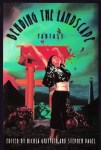 An Exchange of Hostages, Susan R Matthews (1997)
An Exchange of Hostages, Susan R Matthews (1997)
Bending the Landscape: Fantasy, Nicola Griffith & Stephen Pagel (1997). I’m not sure these two books deserve to be lumped together, although I suspect I first read them around the same time. I can’t remember what clued me into Susan R Matthews’s novels – a review somewhere, I suspect – but I’ve remained a fan since reading An Exchange of Hostages. They’re not perfect, and what worked in 1997 doesn’t play as well in 2019, but it’s a remarkable series and worth reading. The Bending the Landscape series, on the other hand, only comprised three volumes – fantasy, science fiction and horror. The remit was simple: genre authors write LGBT genre stories, LGBT authors write LGBT genre stories. The results were… mixed. The idea now sounds seems somewhat quaint, which gives you an idea of the progress made in genre fiction. I value the series because it introduced me to authors I had not previously known. But science fiction as a genre has always been very hetero- and cis- and even in the late 1990s finding commercial fiction that was neither was difficult. The Bending the Landscape trilogy were important in redressing that balance.
Coelestis, Paul Park (1993). I know this was the first Park novel I ever read, and I know I bought it in Abu Dhabi. I suspect it was in All Prints, not Isam Bookshop, as it cost more than 5 Dirhams and was not remaindered. John Clute described it as “Third World sf”, but to me it’s one of the first post-colonial science fiction works. I’m surprised it hasn’t been properly studied. It deserves to be in the SF Masterworks series. It’s been a favourite sf novel for a couple of decades, and Park is a favourite writer. I have all of his books. In first edition.
 Holy Fire, Bruce Sterling (1996). I’m not sure which Sterling novel I read first, possibly Schismatrix, but by the early 1990s, after the success of Mirrorshades, the 1986 cyberpunk anthology he co-edited with William Gibson, and the spread of awareness of “The Movement”, Sterling had become something of a cyberpunk guru. Among the group of fans mentioned above, he was known as “Chairman Bruce”. While I read and appreciated his novels, it wasn’t until Holy Fire – arguably post-cyberpunk – that I saw up and took notice. And later went on to buy his novels as they were published. In first edition. Holy Fire remained my favourite Sterling novel until 2009’s The Caryatids – and I was fortunate enough to interview Sterling for Interzone in connection with that novel. It is, I think, my best interview.
Holy Fire, Bruce Sterling (1996). I’m not sure which Sterling novel I read first, possibly Schismatrix, but by the early 1990s, after the success of Mirrorshades, the 1986 cyberpunk anthology he co-edited with William Gibson, and the spread of awareness of “The Movement”, Sterling had become something of a cyberpunk guru. Among the group of fans mentioned above, he was known as “Chairman Bruce”. While I read and appreciated his novels, it wasn’t until Holy Fire – arguably post-cyberpunk – that I saw up and took notice. And later went on to buy his novels as they were published. In first edition. Holy Fire remained my favourite Sterling novel until 2009’s The Caryatids – and I was fortunate enough to interview Sterling for Interzone in connection with that novel. It is, I think, my best interview.
 Cotillion, Georgette Heyer (1953). For much of the 1990s I was in an APA with a group of well-known UK science fiction fans. It was a bit like a postal forum or group blog. Each month, the members would write a contribution of one or more sides of A4 (you didn’t have to contribute every month, but were expected to do so a certain number of times a year), make 30 copies of it and then send them to the administrator. Who would then put together 30 envelopes containing a copy of each of the contributions for that month, which was then posted to each member. Although the APA was ostensibly about science fiction and fantasy, the discussion often ranged over a wide variety of topics, including other literary genres. I forget who recommended the novels of Georgette Heyer – I think it was after I’d read a Jane Austen novel – but I thoroughly enjoyed Cotillion, and slowly worked by way through Heyer’s historical romances. I still have all the ones I bought and occasionally reread them – they make excellent comfort reading.
Cotillion, Georgette Heyer (1953). For much of the 1990s I was in an APA with a group of well-known UK science fiction fans. It was a bit like a postal forum or group blog. Each month, the members would write a contribution of one or more sides of A4 (you didn’t have to contribute every month, but were expected to do so a certain number of times a year), make 30 copies of it and then send them to the administrator. Who would then put together 30 envelopes containing a copy of each of the contributions for that month, which was then posted to each member. Although the APA was ostensibly about science fiction and fantasy, the discussion often ranged over a wide variety of topics, including other literary genres. I forget who recommended the novels of Georgette Heyer – I think it was after I’d read a Jane Austen novel – but I thoroughly enjoyed Cotillion, and slowly worked by way through Heyer’s historical romances. I still have all the ones I bought and occasionally reread them – they make excellent comfort reading.
 The Master Mariner, Nicholas Monsarrat (1978). I remember reading Monsarrat’s The Cruel Sea at school as part of a reading group, but I didn’t discover Monsarrat had written other books until I joined the Daly Community Library and saw several of his books on their shelves. The Master Mariner, comprising two volumes, Running Proud and Darken Ship, was Monsarrat’s last work and is unfinished. Running Proud is complete, but Darken Ship consists only of a handful of chapters and notes. They’re excellent and I later began working my way through Monsarrat’s oeuvre, and even collecting them in first edition. I think Monsarrat’s oeuvre told against him, and the fact he’s best known for The Cruel Sea had him pegged as a WWII writer. He wrote across a number of genres, including science fiction. Although rarely mentioned in the same breath, the writer closest to him is probably Nevil Shute, whose profile is much higher. I will admit to a tendency to privilege the underdog (relatively speaking, of course), but that’s perhaps because I find lesser reputations are typically undeserved after reading the author’s works.
The Master Mariner, Nicholas Monsarrat (1978). I remember reading Monsarrat’s The Cruel Sea at school as part of a reading group, but I didn’t discover Monsarrat had written other books until I joined the Daly Community Library and saw several of his books on their shelves. The Master Mariner, comprising two volumes, Running Proud and Darken Ship, was Monsarrat’s last work and is unfinished. Running Proud is complete, but Darken Ship consists only of a handful of chapters and notes. They’re excellent and I later began working my way through Monsarrat’s oeuvre, and even collecting them in first edition. I think Monsarrat’s oeuvre told against him, and the fact he’s best known for The Cruel Sea had him pegged as a WWII writer. He wrote across a number of genres, including science fiction. Although rarely mentioned in the same breath, the writer closest to him is probably Nevil Shute, whose profile is much higher. I will admit to a tendency to privilege the underdog (relatively speaking, of course), but that’s perhaps because I find lesser reputations are typically undeserved after reading the author’s works.
 The Second Angel, Philip Kerr (1998). I’d come across Kerr very early in the 1990s when I read the first three Bernie Gunther novels, possibly borrowed from Coventry City Library. Kerr later returned to the Gunther series after a 15 year gap in 2006. But he also wrote other novels, some of which it has to be said are bit potboiler-ish, but among them is The Second Angel, which is pure science fiction. And very good too. I thought it so good I started reading the rest of Kerr’s books, and was especially glad he started writing Bernie Gunther novels again as they really are very good. Sadly, Kerr died in 2018. I’ve read all of his books except his last one, Metropolis, a Gunther novel, the children’s books he published as PB Kerr, and his “football detective Scott Manson trilogy.
The Second Angel, Philip Kerr (1998). I’d come across Kerr very early in the 1990s when I read the first three Bernie Gunther novels, possibly borrowed from Coventry City Library. Kerr later returned to the Gunther series after a 15 year gap in 2006. But he also wrote other novels, some of which it has to be said are bit potboiler-ish, but among them is The Second Angel, which is pure science fiction. And very good too. I thought it so good I started reading the rest of Kerr’s books, and was especially glad he started writing Bernie Gunther novels again as they really are very good. Sadly, Kerr died in 2018. I’ve read all of his books except his last one, Metropolis, a Gunther novel, the children’s books he published as PB Kerr, and his “football detective Scott Manson trilogy.
 The Children of Anthi, Jay D Blakeney (1985). The more observant among you will have noticed that most of the books in this post, and the two preceding, have been by male writers. I did not at that time note the gender of the authors whose books I read. I did read some female science fiction authors – and indeed some were favourites, such as Cherryh – but my reading was predominantly genre books by male writers. The Children of Anthi, and its sequel Requiem for Anthi, are not generally held up as great science fiction, although they’re much better than they should be. Blakeney is a pseudonym used by Deborah Chester for four sf novels published between 1985 and 1990. I’ve never read anything else by Chester other than her Blakeney books, and she used a number on pen-names. The Children of Anthi is an excellent exemplar of one stream of my science fiction reading during the decade, possibly inspired by Angel at Apogee: I actively sought out books by female US mid-list sf authors – at least in Isam Bookshop which, fortunately, seemed to have a good supply. This later fed into SF Mistressworks, a project I kicked off in 2010.
The Children of Anthi, Jay D Blakeney (1985). The more observant among you will have noticed that most of the books in this post, and the two preceding, have been by male writers. I did not at that time note the gender of the authors whose books I read. I did read some female science fiction authors – and indeed some were favourites, such as Cherryh – but my reading was predominantly genre books by male writers. The Children of Anthi, and its sequel Requiem for Anthi, are not generally held up as great science fiction, although they’re much better than they should be. Blakeney is a pseudonym used by Deborah Chester for four sf novels published between 1985 and 1990. I’ve never read anything else by Chester other than her Blakeney books, and she used a number on pen-names. The Children of Anthi is an excellent exemplar of one stream of my science fiction reading during the decade, possibly inspired by Angel at Apogee: I actively sought out books by female US mid-list sf authors – at least in Isam Bookshop which, fortunately, seemed to have a good supply. This later fed into SF Mistressworks, a project I kicked off in 2010.















